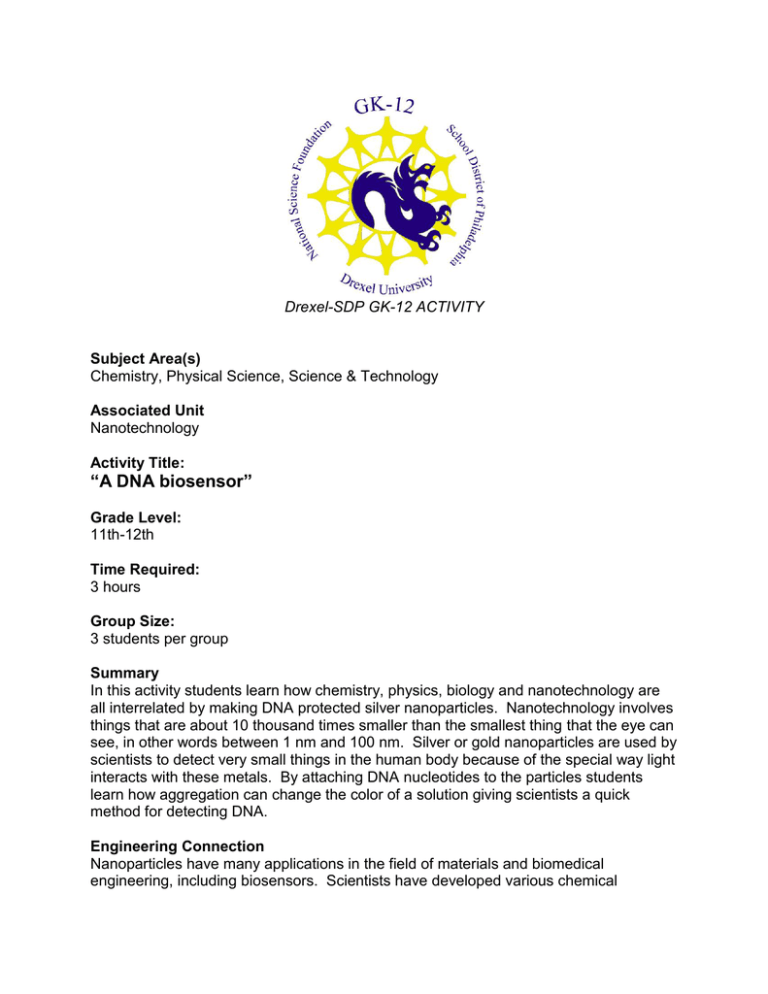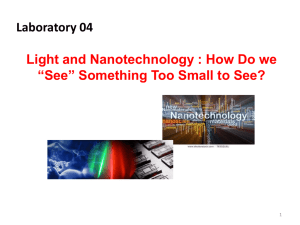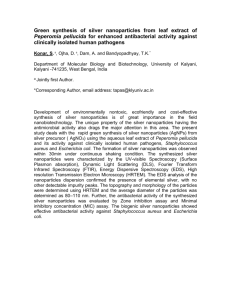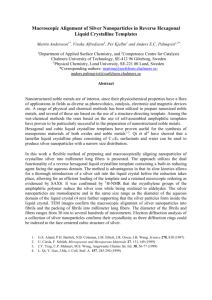“A DNA biosensor”
advertisement

Drexel-SDP GK-12 ACTIVITY Subject Area(s) Chemistry, Physical Science, Science & Technology Associated Unit Nanotechnology Activity Title: “A DNA biosensor” Grade Level: 11th-12th Time Required: 3 hours Group Size: 3 students per group Summary In this activity students learn how chemistry, physics, biology and nanotechnology are all interrelated by making DNA protected silver nanoparticles. Nanotechnology involves things that are about 10 thousand times smaller than the smallest thing that the eye can see, in other words between 1 nm and 100 nm. Silver or gold nanoparticles are used by scientists to detect very small things in the human body because of the special way light interacts with these metals. By attaching DNA nucleotides to the particles students learn how aggregation can change the color of a solution giving scientists a quick method for detecting DNA. Engineering Connection Nanoparticles have many applications in the field of materials and biomedical engineering, including biosensors. Scientists have developed various chemical methods to reproducibly make nanoparticles of different diameters to take advantage of their optical properties. Engineers especially materials engineers develop different applications for these nano-scale structures. Keywords Nanotechnology, silver nanoparticles, DNA Educational Standards Science: 3.2.12.B Science: 3.4.10.A, C Science: 3.4.12.A, B Science: 3.7.12.A Math: 2.2.11.F Math: 2.5.11.B Pre-Requisite Knowledge Understand molar concentrations Know the 4 DNA nucleotides Learning Objectives After this lesson, students will be able to: Identify the uses of silver nanoparticles in the field of nanotechnology and biosensors. Practice the steps in synthesizing silver nanoparticles by the reduction of silver nitrate with sodium borohydride. Recognize that the size of nanoparticles can be correlated to the color of the solution. Attach DNA nucleotides to silver nanoparticles and detect the nucleotide by the color change. Materials List Each group needs: 0.25 mM DNA nucleotides (adenine, cytosine, guanine, uracil and thymine) 200 L micropipette 250-mL Erlenmeyer flask Buret Clamp and a ring stand 50-mL graduated cylinder (2) 1 mM AgNO3 (10 mL) 2 mM NaBH4 (30 mL) ice Spectronic-20 10 mL test tubes (7) Computer with Microsoft Excel 2 Introduction / Motivation What if we could add something into the body that would specifically interact with certain tissues and then shoot it with a laser to detect it? This is being done today in numerous research labs across the country with the use of nanoparticles. Nanoparticles are very tiny metal spherical particles ranging in size between 1 nm and 100 nm that can be inserted into tissues to target cancerous cells or different molecules. Since they are so tiny they cannot be seen by the naked eye but have special optical properties when its electrons are excited by a laser beam. Silver nanoparticles, for example, can change colors when they are aggregated in a solution. By adding different ionic components we change the color of the colloid solution. By attaching DNA nucleotides to the silver colloid we should be able to differentiate between the 4 DNA nucleotides, adenine, cytosine, guanine and thymine. Today you will attach DNA to silver nanoparticles and then use your biosensor to identify the unknown DNA nucleotide. Vocabulary / Definitions Word Definition Aggregation The coupling of nanoparticles into larger clusters due to ionic attractions Colloid A substance containing tiny particles dispersed within another substance Nanoparticle Spherical nanoparticles with diameters ranging between 1 nm to 100 nm Nucleotide These are molecules that make up the structure of DNA Plasmon Cloud of free electrons oscillating around the nanoparticle Spectroscopy The interaction of radiation (light) with matter (silver nanoparticles) Procedure Background Silver nanoparticles are made through the sodium borohydride reduction of silver nitrate (equation below) which produces nanoparticles with an average diameter of 12 nm. The solution will turn clear yellow if done correctly. A similar procedure is used to make glass stained church windows [1]. AgNO3 + NaBH4 Ag + ½ H2 + ½ B2H6 + NaNO3 The yellow color produced by the silver nanoparticles occurs because its plasmon absorbance is around 400 nm. When light interacts with the free electrons of the silver nanoparticles they vibrate at a certain frequency causing light to scatter at a specific frequency. This frequency can be measured using a spectrometer. Depending on the aggregation and the frequency of vibration the nanoparticles will turn different colors. By adding DNA nucleotides to the silver colloidal solution we can change the aggregation of the silver nanoparticles and therefore cause a shift in the plasmon 3 absorbance band and thus the color of the solution. It is important to note that the chemical structure of DNA plays a role in the binding to silver (Figure 1). The lone pair on the exocyclic nitrogen is mostly responsible for the binding to silver [2]. The placement of this nitrogen bond can influence the aggregation characteristics of the silver. Figure 1: Chemical structure of DNA nucleotides [2] . Before the Activity Make a stock solution of 1 mM sodium borohydride by mixing 37.8 mg of NaBH4 into 500 mL of distilled water. Make a stock solution of 2 mM silver nitrate by mixing 85 mg of AgNO3 into 500 mL of distilled water. The sodium borohydride needs to be cooled for 20 minutes in an ice bath before the start of the activity. The stock solutions for the DNA nucleotides (adenine, cytosine, guanine and thymine) have to be made before the start of the activity. Adenine and guanine will not dissolve in distilled water so first dilute it in 5% sodium hydroxide and then dilute it into a 10 mM solution in distilled water. With the Students Synthesis of silver nanoparticles: This part of the procedure can be found on the Philadelphia Science in Motion website [3] . Briefly the following steps should be followed: 1. Collect 30 mL of the sodium borohydride solution into an Erlenmeyer flask and place it on top of a stir plate. 2. Collect 10 mL of the silver nitrate solution into a Buret secured by a clamp on a ring stand. This should be placed just above of the flask 3. Place a stir bar in the flask and star stirring. 4. Open the buret and allow the silver nitrate to fall into the flask about 1 drop per second and stop stirring as soon as all of the silver nitrate is added. 5. Wait 5 minutes and then record the color of the solution (it should be light yellow – dark yellow). 4 Addition of DNA nucleotides 1. Take 1 mL of the freshly prepared silver colloid and mix it with 11 parts of distilled water to obtain a concentration of 0.25 mM silver colloid. 2. Pour 3 mL of the silver colloid into each of the 4 test tubes. 3. Add 30 uL of each of the 10 mM DNA nucleotide solutions to the yellow silver colloidal solution (0.25 mM, 3mL) and stir. 4. Solutions should change color as seen in Figure 2. Figure 2: Color changes of nucleotides in silver solution: silver colloid (yellow green), thymine (yellow), [2] adenine (orange), guanine (reddish-green), and cytosine (blue-green) . Measuring absorption of the solutions 1. Fill a separate test tube with distilled water to serve as the control. 2. Place the water test tube in the Spec-20 and close lid. Adjust transmission until it equals 1. 3. Place DNA sample into test tube holder and measure the transmission. 4. Repeat steps 2-3 from wavelengths 350 nm to 800 nm (10 nm intervals) 5. To get absorbance for each wavelength subtract transmission recorded from 1. 6. Repeat steps 2-5 for all of the DNA nucleotides 7. Graph the absorbance of each DNA nucleotide versus the wavelength on an Excel Spreadsheet. They should appear similar to figure 3 8. In a separate test tube add DNA unknown sample to silver colloid solution and observe what color it changes. From your samples created identify the unknown sample. 5 Figure 3: Graph of the absorbance versus wavelength of the silver colloid (a) and the DNA nucleotides: [2] thymine (b), adenine (c), guanine (d), and cytosine (e) . Troubleshooting Tips All students should rinse supplies out with distilled water to make sure there is no residue in the glassware. Make sure the students do not reuse the graduated cylinders when collecting the silver nitrate and sodium borohydride unless they rinse them out a few times with distilled water. Investigating Questions 1. Why was more sodium borohydride (30 mL) added than silver nitrate (10 mL)? 2. Based on the color change and the absorbance graphs which DNA nucleotide interacted the most with the silver colloidal solution? 3. Draw a picture of what you think the molecular arrangement of the silver nanoparticles relative to the DNA nucleotides looks like once they attach. Assessment Pre-Activity Assessment Title: Class discussion Before handing out the protocol students are asked to brainstorm what they think their silver nanoparticles will look like and what will happen when DNA nucleotides are added. Activity Embedded Assessment Title: Graphing absorbance versus wavelength During the activity students will take their transmission data and use it to graph absorbance versus wavelength. By identifying the peaks of the unknown sample and 6 comparing it to their nucleotide data students should correctly pick out the unknown nucleotide. Post-Activity Assessment Title: Class discussion After the activity, students are asked to explain on a piece of paper what the wavelength corresponding to the peaks on the absorbance graphs mean and why did it change as they added different DNA nucleotides. References 1. Solomon, S.D., et al., Synthesis and study of silver nanoparticles. Journal of Chemical Education, 2007. 84(2): p. 322-325. 2. Basu, S., et al., Interaction of DNA bases with silver nanoparticles: Assembly quantified through SPRS and SERS. Journal of Colloid and Interface Science, 2008. 321: p. 288-293. 3. Synthesis and Study of Colloidal Silver Lesson #29. Philadelphia science in motion. Owner Drexel University GK-12 Program Contributors Mr Manuel FigueroaManuel Figueroa, PhD Candidate, School of Biomedical Engineering, Drexel University Mr Ben Pelleg, PhD Candidate, College of Engineering, Drexel University Mr Matt Vankouwenberg, Engineering Teacher, Science Leadership Academy, School District of Philadelphia Copyright Copyright 2010 Drexel University GK-12 Program. Reproduction permission is granted for non-profit educational use. 7








